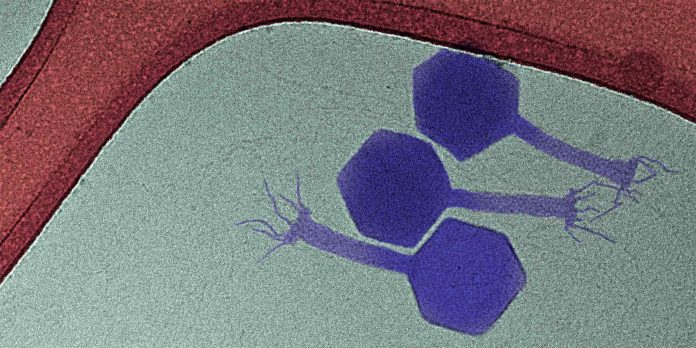Бактэрыяльная dormancy is survival strategy in response to stressful exposure to antibiotics taken by a patient for treatment. The dormant cells become tolerant to antibiotics and are killed at slower rate and survive sometimes. This is called ‘antibiotic tolerance’ which is unlike antibiotic resistance when бактэрыі grow in the presence of antibiotics. Chronic or relapsing infections are attributed to antibiotic tolerance, for which there is no effective treatment. Phage therapy has long been considered but the dormant bacterial cells are non-responsive and refractory to known bacteriophages. Scientists of ETH Zurich have identified a new bacteriophage that uniquely replicates on deep stationary-phase cultures of Pseudomonas aeruginosa. Named ‘Paride’, this bacteriophage could kill deep-dormant P. aeruginosa by direct lytic replication. Interestingly, this novel phage reduced bacterial loads through phage-antibiotic synergy when meropenem antibiotic was added to cultures. Apparently, the novel phage could exploit weak spots in the physiology of dormant bacteria to overcome antibiotic tolerance. These weak spots could be targets of new treatment for chronic infections caused by dormant or inactive bacteria.
Most bacteria on Earth are in dormant state of reduced metabolic activity or in completely inactive form of spore. Such бактэрыяльны cells can be readily resuscitated when required nutrients and molecules become available.
Бактэрыяльная dormancy or inactivity is the survival strategy in response to stressful external environmental conditions like starvation or exposure to antibiotics taken by a patient for treatment. In later case, the dormant cells become tolerant to antibiotics because cellular processes targeted by the antibiotics to kill бактэрыі are turned down. This phenomenon is called ‘талерантнасць да антыбіётыкаўу гэтым выпадку бактэрыі гінуць павольней і часам выжываюць (у адрозненне ад ўстойлівасць да антыбіётыкаў калі бактэрыі растуць у прысутнасці антыбіётыкаў). Хранічныя або рэцыдывавальныя інфекцыі тлумачацца латэнтнымі бактэрыяльнымі клеткамі, устойлівымі да антыбіётыкаў, якія часта называюць «персістэрамі», для якіх не існуе эфектыўнага лячэння.
Phage therapy involving bacteriophages or phages (i.e., вірусы that predate бактэрыі), has long been considered for treating chronic infections by dormant or inactive бактэрыі however this approach works when host бактэрыяльны cells are undergoing growth. The dormant or inactive бактэрыяльны cells, however, are non-responsive and refractory to the bacteriophages which either avoid adsorption to the бактэрыяльны cell surfaces or hibernate in the dormant cells until resuscitation.
Known bacteriophages do not have ability to infect antibiotic-tolerant, deep-dormant or inactive бактэрыі. It was thought that given diversity, phages with ability to infect dormant cells may exist in nature. Researchers have now identified one such novel bacteriophage for the first time.
У нядаўна апублікаваным даследаванні навукоўцы з ETH Zurich паведамляюць аб выдзяленні новага бактэрыяфага, які адназначна рэплікуецца на глыбокіх культурах стацыянарнай фазы сінегнойную у лабараторыі. Яны і назвалі гэты бактэрыяфага Парыдэ. Гэты фаг мог знішчыць глыбока спячых P. aeruginosa шляхам прамой літычнай рэплікацыі. Цікава, што гэты новы фаг знізіў бактэрыяльную нагрузку дзякуючы сінэргіі фага і антыбіётыка пры даданні антыбіётыка мерапенема P. aeruginosa-фагавых культур.
Па-відаць, новы фаг можа выкарыстоўваць слабыя месцы ў фізіялогіі спячых бактэрый, каб пераадолець талерантнасць да антыбіётыкаў. Гэтыя слабыя месцы могуць быць мішэнямі новага лячэння хранічных інфекцый, выкліканых спячымі або неактыўнымі бактэрыямі.
***
Спасылка:
- Maffei, E., Woischnig, AK., Burkolter, MR і інш. Phage Paride можа знішчаць спячыя, талерантныя да антыбіётыкаў клеткі Pseudomonas aeruginosa шляхам прамой літычнай рэплікацыі. Nat Commun 15, 175 (2024). https://doi.org/10.1038/s41467-023-44157-3
***






































